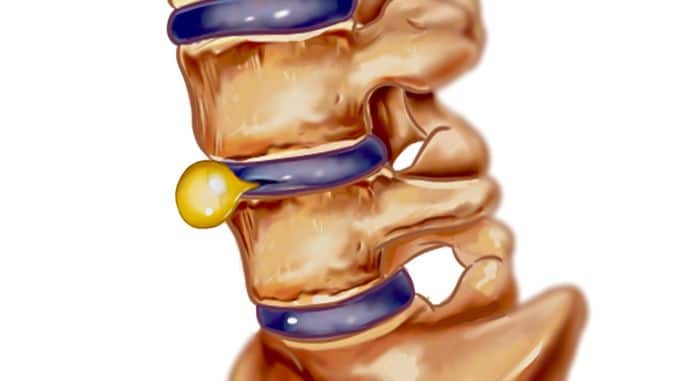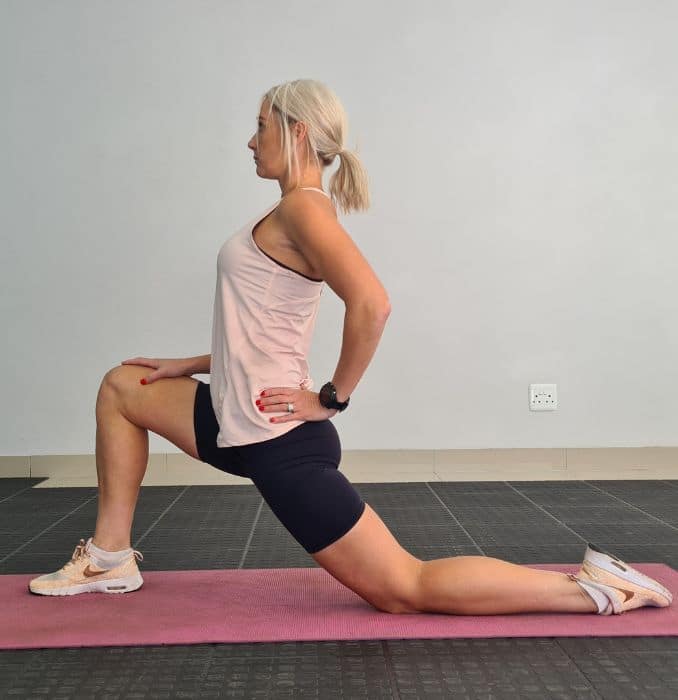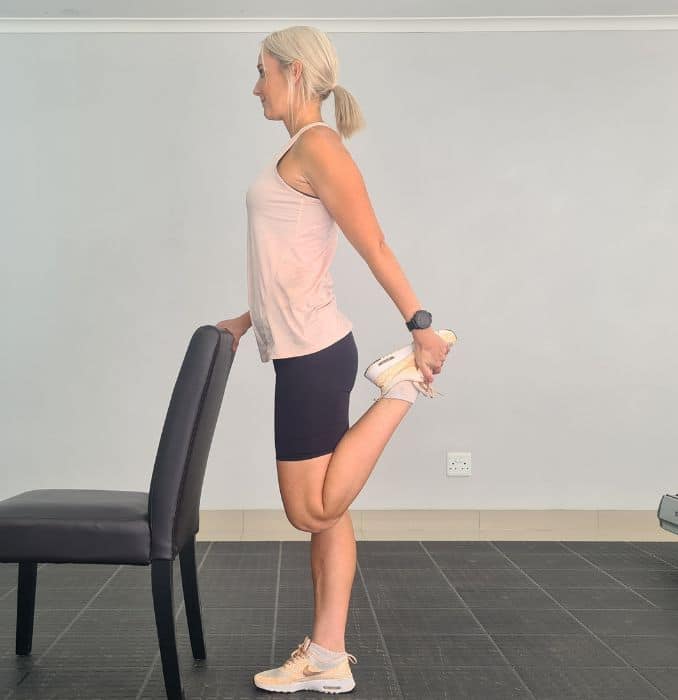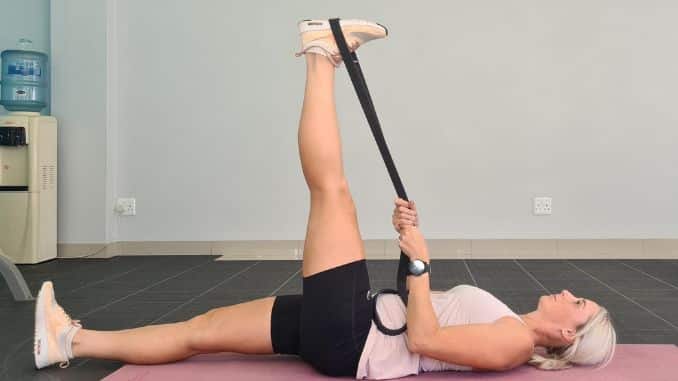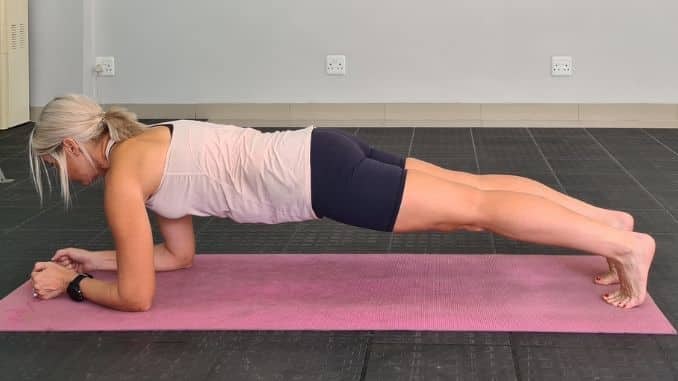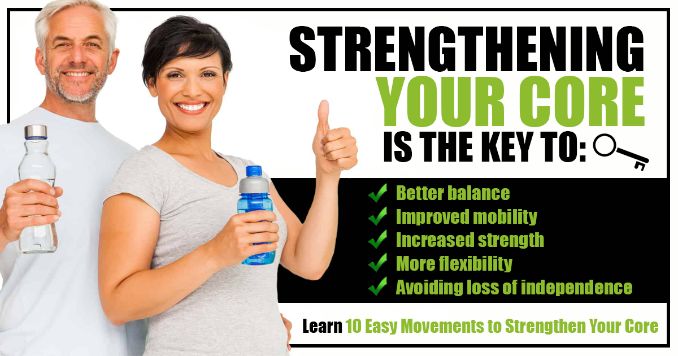
A sports hernia is an injury to tissues in the groin that surround the area where a typical inguinal hernia presents. The surrounding tissues present with an injury because of the weakness of the inguinal floor within the groin. So, the patient succumbed to the symptoms of strain and injury on the surrounding tissue. Treatment varies according to the severity of the hernia. A small tear may require only rest, icing and anti-inflammatory medication, and physical therapy to repair. However, in cases of more significant damage, hernias may need surgery. Below are Sports Hernia Stretches that can also be of help.
Inflammation may be reduced by applying ice to the affected area and taking anti-inflammatory medications. There is a need to avoid the activity that caused the injury for a full 6-week period at least. If you resume the sports activity that caused your injury after taking 6 weeks of rest and the groin pain returns, we recommend trying an additional six weeks of avoiding that activity.
Treatment And Management
A combination of stretching and strengthening or Sports Hernia Stretches will restore coordination of the entire core to treat, manage, and prevent future injuries in the groin or abdominal wall.
I. Stretching
Stretching the affected muscles around the core that may be tight and imbalanced can give some much-needed groin pain relief. The focus will be on stretching the sore groin and other larger muscle groups in the hip to boost local flexibility and range of motion.
1. Butterfly Stretch
For this Sports Hernia Stretches, You can use your hands or a stretch strap for this one. The focus is on the commonly sore inner thigh muscles or hip adductors. The stretch strap is best if you can’t reach your feet comfortably or you want to deepen the stretch.
Start by sitting on the floor. Then, place the bottoms of your feet together with the hips rotated outward and knees pointing away from each other – how high your knees are off the ground will depend on your general flexibility. Afterward, bring the heels closer to your butt, as far as is comfortable, until a stretch is felt in the inner thighs. For a deeper stretch, bring the knees closer to the floor by using your elbows for overpressure. Lastly, hold for 30+ seconds for 2-3 sets total.
2. Kneeling Hip Flexor Stretch
Tight hip flexors, the large muscle groups that cross the front of the hip and pelvis, can throw the entire core out of balance. A gentle hip flexor stretch can be powerful for relief and recovery.
Start by long kneeling on the floor with both legs. Then, bring the foot opposite of the hip you want to stretch forward and place it flat on the ground in front of you – with the hip and knee both at approximately 90 degrees of bend. Afterward, make sure the knee on the ground is directly under the hip to start. Next, think about sending your hips forward (as you shift your weight forward) until you feel a stretch along the entire front of the hip.
Moreover, you can try a cushion under the knee for comfort too. Don’t forget to keep the hips square throughout to prevent rotation of the spine. Then, hold for 30+ seconds for 2-3 sets on each leg. To intensify the stretch, you can shift deeper or add a gentle side bend toward the knee that is in front. Alternatively, you can also try this stretch while standing if kneeling is not tolerable.
3. Standing Quad Stretch
For this Sports Hernia Stretches, stand in a comfortable position with the feet hip-width apart. Use a chair at your desk for this stretch or wall for balance as needed. Then, lift one foot off the ground and bend the knee so that you can grab the top of your ankle with the hand on the same side.
Once you have secured your ankle, gently bring the heel closer to the butt with the guidance of your hand. Pull until you feel a gentle stretch in the front of the thigh. Then, keep the knee under the hips or slightly behind- if it is possible without arching the back. Afterward, do not let your hips hike to one side or low back arch during this stretch. Lastly, hold for 30+ seconds for 2-3 sets on each leg.
4. Hamstring Stretch
Hamstring tension can play a large role in groin pain because of its influence on the pelvis. Grab a stretch strap, towel, or belt for this stretch to get started.
Lie on your back and wrap your stretching tool around the mid-foot of the leg you want to stretch. Then, with a straight knee, bring your entire leg up toward your chest. Continue pulling until you feel a stretch in the back of the leg, and hold. Focus on staying relaxed and hold for 30+ seconds for 2-3 sets on each leg.
5. Banded Hip Flexion
Attach a resistance band to a fixed object, lie down on the ground, and wrap it around your left foot. Then, position yourself so there’s tension in the band. With your core tight and feet dorsiflexed, bend your left knee and hip until both joints are at a 90-degree angle. Slowly straighten your leg to return to the starting position.
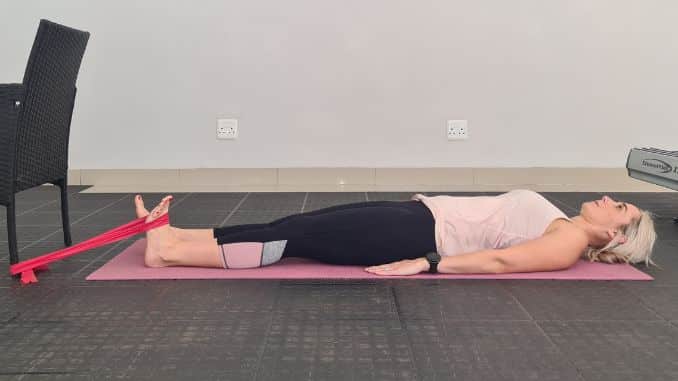 |
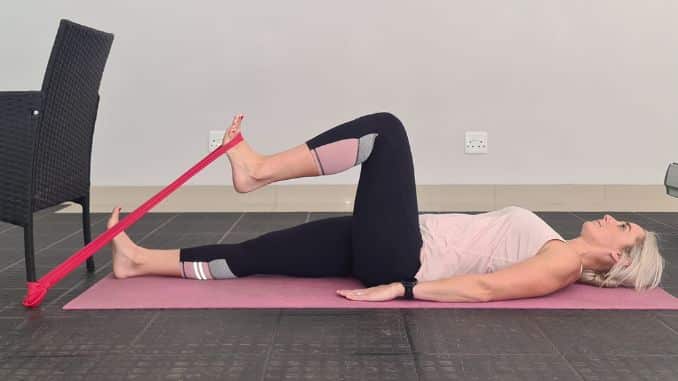 |
II. Strength
Addressing the core muscle strength is a key factor in recovering from and preventing continued issues with a sports hernia in the future. Plus, there are so many great benefits to core strengthening for improving your endurance, coordination, and quality of life. All these Sports Hernia Stretches address sustainable core strength.
1. Glute Bridge Leg Lifts
Lie on the ground with your knees bent and feet flat on the ground, positioned about hip-width apart. Then, place a med ball between your knees and squeeze it with your legs. Drive your hips up as if performing a Glute Bridge. Afterward, tighten your core and glutes to create stability in this position. Without moving your hips, slowly straighten your left leg before returning it to the starting position. Lastly, repeat with your opposite leg and continue alternating back and forth.
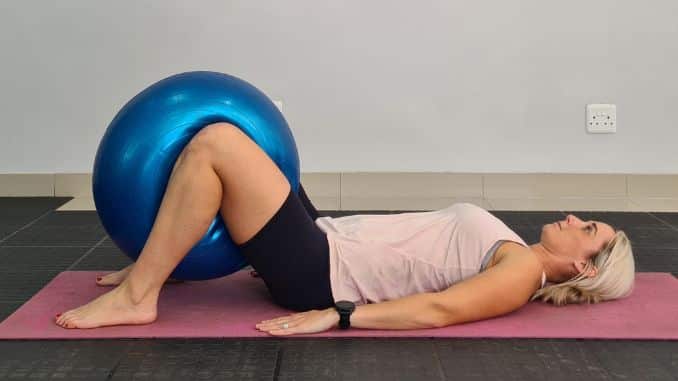 |
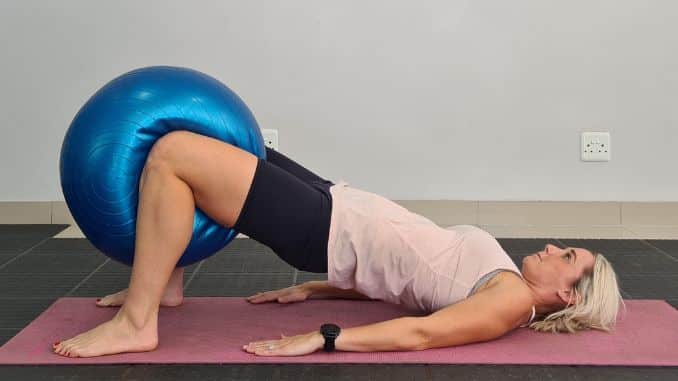 |
2. Double Leg Toe Taps
Lie on your back with the abs tight. Bring both knees up toward the sky while keeping your back relatively flat – a slight arch is okay for the lumbar spine, but nothing more. Then, bring both your feet back down to touch the floor. Your back should stay stable and flat against the floor with minimal wobbling. Repeat for 10-15 repetitions for 2-3 sets. If this move is too hard – simply modify it to one leg at a time.
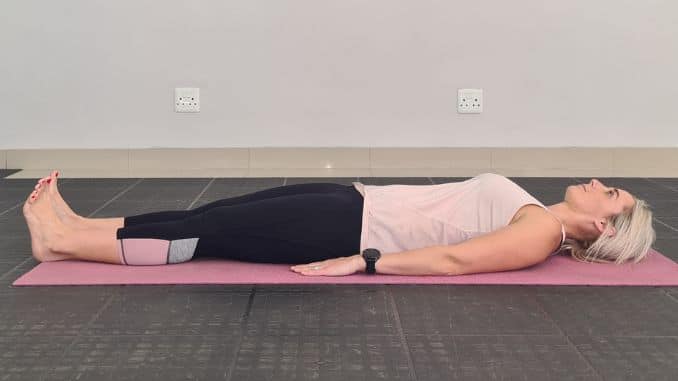 |
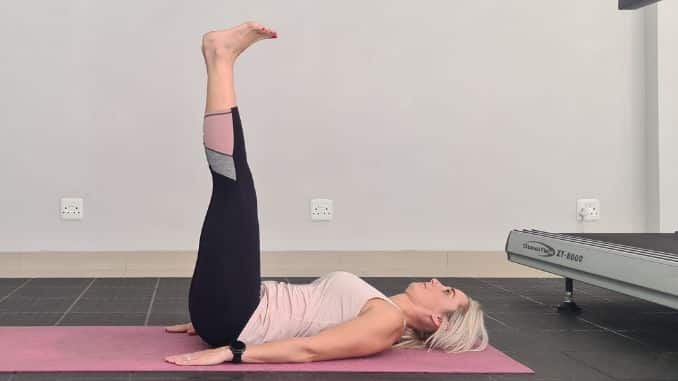 |
3. Clam Shells
Groin pain related to a sports hernia can also be caused by an underlying imbalance in the hip rotators – specifically the external rotators, which is the main action of the gluteus medius. This exercise will give the side of your butt and hip a great burn for restoring better balance in relation to the inner hip.
Lie on your side, with the hip you want to work facing up. Make sure the hips, legs, shoulders, and feet are all stacked directly on top of each other. Have the knees and hips bent so that the knees are in front of the body and the feet are in line with the rest of the body. Finally, lift the top knee up toward the ceiling while keeping the feet together.
Do not let the hip or trunk roll back – if it is, try to better control your core by keeping the lower abs tight or making the motion smaller. Repeat for 10-15 repetitions for 2-3 sets on each leg.
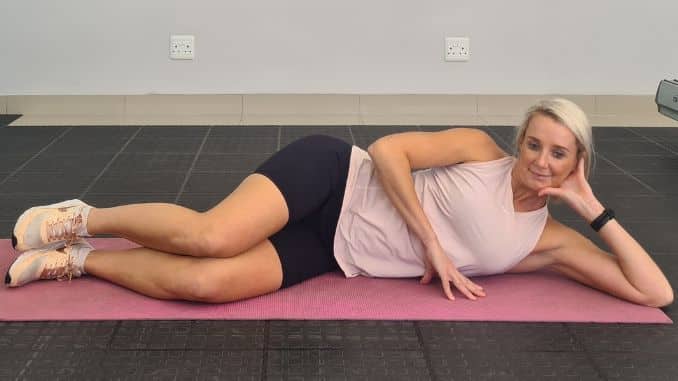 |
 |
4. Bird Dog
These classic Sports Hernia Stretches are great for training full body coordination while activating the core. Plus, it works your hip muscles for an added benefit to your groin.
Start by getting on all fours with your hands directly under the shoulders. Push your hands “down” into the ground to activate the shoulders and keep them from sagging. Keep the abs tight and the back relatively flat. Then, lift one arm and the opposite leg at the same time- extending them both as far as possible (arm forward and leg extended backward).
Hold the end position for 1-2 seconds before slowly returning to the starting position and repeating. Make sure there is no rotation in the spine or arching of the low back throughout. Focus on one side at a time, repeat for 10-15 repetitions on each side for 2-3 sets. If this move is too hard to control- you can start with just the legs
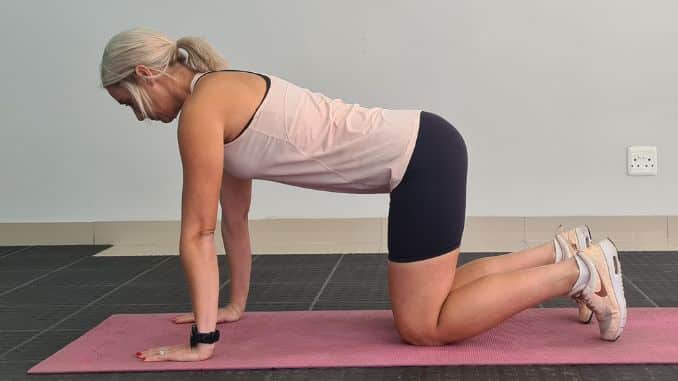 |
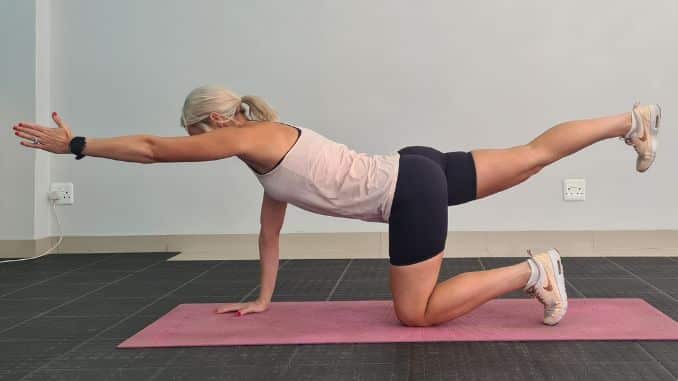 |
5. Plank
A plank is always a great way to get the core worked up, as well as the entire body. This high-impact exercise should only be completed with good form and if it’s pain-free. You can start on your forearms and knees and then progress to your hands and toes when you feel ready and in control.
Start by getting on your hands and knees, or assume an all-fours position. Place both your forearms on the ground with your elbows directly under the shoulders. Push the elbows into the ground to bring tension to the shoulders and mid-back. Make sure the entire body is aligned- no bending at the hip (butt up) or excessive arching of the low back as you shift your weight to only your knees and forearms. Keep your stomach tight and hold for 30+ seconds. Repeat for 2-3 sets total, increasing time as tolerated.
Movements To Avoid
In general, high-impact or other high-exertion activities will aggravate after the onset of a sports hernia. Additionally, any exercise that exerts too much force on the abdominal muscles can also be problematic. Any exercise that increases your symptoms should be avoided until adequate rest is allowed. If you are an athlete, this may mean taking a little more rest time than you’d like, but it will definitely help prevent future issues.
Common aggravating movements include:
- Running
- Jumping
- Kicking a ball
- Flexion-based ab exercises such as sit-ups and crunches
- Heavy weight lifting
- High-impact sports such as baseball, football, skiing, rugby, and volleyball
Recovering from a sports hernia can be straightforward with the right rest time, exercise program, and understanding of the underlying issue. These stretching and strengthening exercises are a great place to start. Additionally, if your symptoms get worse or are not improving, make sure to get in touch with your doctor or physical therapist as soon as possible for further medical advice.
Strengthening your core is THE KEY to better balance, improved mobility, increased strength, more flexibility… and avoiding LOSS OF INDEPENDENCE. Check out our 10 Easy Movements For A Stronger Core now!

